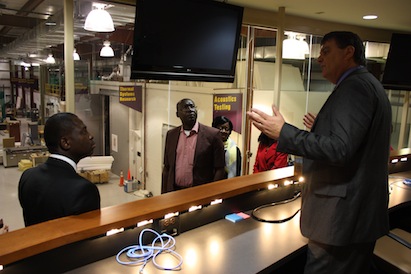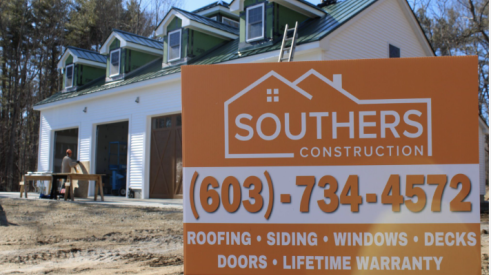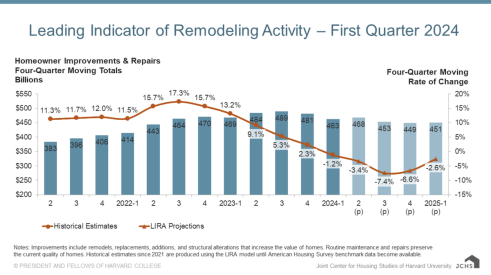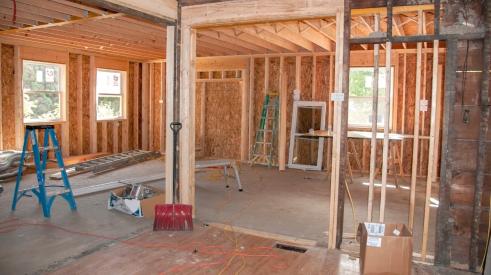This month, we talked to Michael Luzier, president of the NAHB Research Center, a subsidiary of NAHB that is tasked with improving the quality, affordability and durability of housing. Luzier joined the center in 2003, coming from a position as NAHB’s senior vice president of its regulatory affairs program. Under his leadership, the research center launched the National Green Building Certification Program.
PR: Since you joined the research center seven years ago, you’ve seen some dramatic changes in the building and remodeling industries, to put it mildly. What were some of the top issues the center was looking at when you arrived, and how do those compare with its emphasis in 2010?
Luzier: The single biggest change has been in the environmental arena moving from being almost exclusively focused on energy efficiency to a broader scope on sustainability. When we came here, people were concerned about energy and energy efficiency, and that remains. Now, we see increasing confusion of what constitutes a green home and efforts to respond to that.
From my perspective, what we have seen dramatically change is the manner in which we look at these issues. At its core, it’s a technical issue. When I came here, we had a series of practice areas that were almost managed independently of each other. As a result, we had a range of services we weren’t providing because we didn’t take a holistic view. That led to the construction a couple of years ago of a new product testing and market research facility.
PR: The center is ramping up its certification of green remodeling projects through the National Green Building Standards. What’s the benefit to remodelers?
Luzier: As I mentioned, there was confusion in the marketplace about what constituted green. There was conflict. We saw governmental agencies starting to mandate green, but there wasn’t a reference point. ICC 700 was approved by ANSI in January 2009 as the first consensus standard on green building; its progenitor was a set of guidelines we developed in a consensus manner. It is the only consensus standard that specifically defines elements of a green remodeling project or a whole-house rehab. That’s become really important. The existing housing stock is something like 130 million units with a median age of 36 years. They all could stand to have a lot of work. If a homeowner is doing remodeling and is interested in making it green, we have objective information to guide us. It allows remodelers to articulate a value proposition to customers that they couldn’t articulate before because there wasn’t a reference point.
Here’s an example: A few years back, I did a deck remodeling project that turned in to whole-house renovation. If I’d had this, I may have made different selections in terms of flooring, paints and wall coverings, but I didn’t have a reference point and the remodeler didn’t have a reference point to engage the conversation. Now they do.
PR: The standards also offer some legal protection for remodelers, too, don’t they?
Luzier: Part of the concern about not being able to quantify green is that the Federal Trade Commission is working on providing some guidance on marketing green products. It’s significant rule making that’s going on. Because the market is confused, the FTC is saying that any claims need to be specific — you can’t just say it’s a green product. You need to be specific, relative to some performance metric. The national Green Building Standards will provide this reference point.
The FTC has made it clear their plan is to pick a couple of big names and sue the bejeebers out of them. They’ll look for a couple of big remodelers and manufacturers. Certification will provide them with a significant layer of protection against claims of fraudulent advertising.
PR: The center identifies energy efficiency, lead paint remediation and universal design as a key for remodeling and retrofits. We all know why lead paint made the list and we’ve already covered energy efficiency. Why does the center consider universal design a key issue for remodelers?
Luzier: There’s a big aging housing stock. Few of those houses were built to accommodate the features of aging in place. The aging cohort is getting bigger. Combine that with economic stress — fewer people can move because of the mortgage freeze. Those demographic factors are driving the need for universal design. Generally, one of the limits on aging-in-place features is people want the features, but they don’t want to be reminded they’re going to get old, get frail and die. They want features that let them get around, like rails, but they don’t want them to look like rails. They want levers instead of knobs. They hate to think about being bound in a wheelchair, but they want to be able to move from one room to another. … These seem to be conflicting data points. We all know that if we’re lucky, we’re going to get old and have some needs we don’t want to think about. The market tells us there’s a disassociation between expectations and reality. That puts a premium on design and space planning. It’s functional design that’s not in your face.
We can do a lot in design and construction to accommodate those needs in a contextually appropriate way. Remodelers need to understand the features and prepare the home for the features, but make it subtle.
We did a project here; one of the features some of the seniors who looked at it really liked was that it had handrails throughout the house, but if you weren’t next to it, it looked like chair rail. Things like that can really make a difference.
PR: Most remodelers are probably familiar with the work the center does with manufacturers to test products. But you also have government clients. One of the services you provide them is identification and mitigation of barriers to innovation. What are some barriers to innovation in building materials that the center has identified?
Luzier: First is the mom and pop nature of our business. It’s certainly the case in remodeling, and well over half the houses built in the country are done by builders who build 20 houses a year or less. If you’re a product manager introducing a new product, you have a huge challenge.
A new idea in our industry, an innovation, can take up to 30 years to get market adoption. That leads to chronic underinvestment. My engineers will hate me for saying this, but we’re essentially building houses today the same way we did 100 years ago.
Second, this is essentially a local business. There are 48,000 jurisdictions in the country; that local context is extremely important. Not only is the site of production local, it’s also where you’re regulated. That’s a check on innovation. Then, we have a convoluted and deep supply chain. That means it’s hard to invoke discipline in communicating your value proposition. You may be selling to a distributor who sells to a big box. It’s a weight on the system.
Then, the final big one is that new innovation requires approval in the code process. That’s a huge, lengthy process. We have clients who are huge manufacturers who want to do something in the housing industry, but when we tell them what’s involved, their eyes glaze over. Compare that to the approach of the auto industry, where they’d have to talk to three companies. Or the airlines, where they might talk to five companies.
All of those combine to limit innovation in this industry.
PR: I thought you’d say governmental regulations are a barrier to innovation. I hear that a lot.
Luzier: Well, yes, but those are endemic to business, not just the building industry.
PR: Is there any special assistance available for remodelers who are focusing on energy efficiency?
Luzier: We’re a Building American contractor for the Department of Energy. We’re trying to get the technologies to the volumes where the prices can come down to transform the market. One of the big emphases is the renovation of existing houses; the challenges of improving the energy performance of an existing home are much more daunting than a new home. DOE wants to make this a plank in moving toward energy independence. That creates some real opportunities for remodelers. The government is out there, pushing this notion there’s assistance available to lower the cost of conversion. Building America teams offer free consulting.
PR: If you had a dollar for every time someone has asked you when the housing market is going to rebound, what would you be able to do with the money?
Luzier: I could buy a cheeseburger! We don’t get asked this question much because we don’t do housing projections. I see data from NAHB and Treasury; almost every economist says it will be a shallow recovery. From the data we do have, we do believe there’s a return to value. We’re seeing real changes in the way people think about spending their money in terms of remodeling and new home purchase. We don’t see two-story foyers anymore. They’re really expensive. People are downsizing.
On remodeling, people will spend a little more money on what’s behind the walls. People are remodeling because it’s a better investment than buying new, so let me fix up space I’ve got. When I remodeled, I didn’t ask about green or energy efficiency. I had four kids I needed to fit around a kitchen table. I’d ask those questions now. Houses are getting smaller; that puts a premium on design. In a big space, if I make a little bit of a mistake, it’s hidden. That’s where companies will separate themselves.
NAHB Research Center is helping remodelers and builders find ways to incorporate smart practices
Add new comment
Related Stories
Business Coach Cited in Suit Against Contractor
A New England contractor faces a civil suit alleging his company’s growth was tied to a business coach with a model that “encourages fraud.”
Harvard Says Remodeling Spending Downturn to Slow
Could the drop in remodeling spending from post-COVID levels regulate soon?
Power Home Remodeling Now Offers Subsidized Childcare
The home improvement giant's move seeks to address a greater industry issue
Contractor Facing Lawsuit in ‘Major Case’ by Ohio Attorney General
An Ohio custom builder and remodeler faces a lawsuit after alleged losses exceeding $1 million
Learn from the Best in Home Improvement and Remodeling
This year’s Pinnacle Experience aims to help remodelers stay ahead of their competitors by featuring captivating keynote speakers and subject matter experts, collaborative roundtable discussions, and networking with proven players from across the country.
Registration Open for The Pinnacle Experience 2024
Register today for The Pinnacle Experience 2024 in Baltimore from June 26-28. Join the best and brightest in home improvement and remodeling for insight, advice, and relationship-building that will help you take your business to new heights.
Marvin Releases Switchable Privacy Glass Window
The privacy glass windows can be purchased from Marvin's Direct Glaze windows
Gas Ban in New Construction Considered by Chicago
The mayor-backed ordinance would impact all new construction
Working Toward Affordable, Resilient Homes
A new natural disaster protection act from NAHB aims to support hazard mitigation projects
The Remodeling Market Could Turn in Q4, Says Harvard
Repair and remodeling spending could see an uptick at the end of the year












